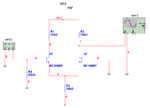zia.newversion
Member level 5
I am not very good at electronics. In my Analog and Digital Electronics Lab last week, I performed a task. The teacher displayed a circuit diagram and gave a brief lecture on the specific type of amplifier... Incidentally, I did not take notes except copying the diagram... I was trying to simulate the same diagram on Multisim today but I am consistently failing to receive an amplified output. The circuit diagram (screenshot from Multisim) and the sim file is enclosed.
Please tell me what silly mistake I am making. I shall be really thankful.
EDIT: I think it is called a "Differential Amplifier"... I have taken the basic electronics course but I am not familiar with this type of amplifier. At first i thought it was a Darlington pair, but then I remembered that D-Pair is two BJTs connected emitter to base... Anyway, I am totally blank on this specific circuit. Some theoretical comments will be helpful.
DISCLAIMER: I am not posting this thread because I have an assignment or a test due... I am asking for your help because I am suddenly very interested in this specific problem.
Please tell me what silly mistake I am making. I shall be really thankful.
EDIT: I think it is called a "Differential Amplifier"... I have taken the basic electronics course but I am not familiar with this type of amplifier. At first i thought it was a Darlington pair, but then I remembered that D-Pair is two BJTs connected emitter to base... Anyway, I am totally blank on this specific circuit. Some theoretical comments will be helpful.
DISCLAIMER: I am not posting this thread because I have an assignment or a test due... I am asking for your help because I am suddenly very interested in this specific problem.
Attachments
Last edited:
